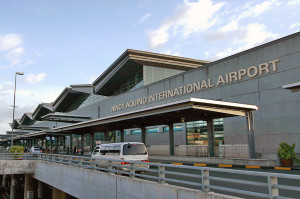The Ninoy Aquino International Airport or NAIA is the only airport servicing travelers in the Manila area.The other airport servicing the residents of Manila and nearby provinces is the Clark International Airport . It is located in Pampanga in Central Luzon and north of Manila.
The Ninoy Aquino International Airport or the NAIA was named after the late senator Benigno “Ninoy” Aquino,Jr. who was killed by a lone gunman at the airport.
The Ninoy Aquino International Airport is located between the cities of Pasay and Parañaque which is just 7 km south of Manila proper, and is the main international approach point for those traveling to the Philippines. The flag carrier airline, the Philippine Airlines, uses the airport as its main hub.

There were 24.1 million aircraft passengers that entered and exited the airport in 2009, which increased to 27.1 million in the following year. In 2011, all terminals at the NAIA achieved a record breaking yearly passenger traffic of 29.55 million heads, making it one of the busiest airports in Asia and becoming the 34th busiest airport in 2012.
Here’s a little history about the NAIA airport.
The Ninoy Aquino International Airport was originally named Manila International Airport which opened in 1948 in an area near Villamor Airbase or Nichols Field. The original structure of the Manila International Airport was built in an area which is now presently occupied by the modern Terminal 2.
The international runway and taxiway of the airport were made in 1954 and the construction of a control tower and a terminal building for use by international passengers began in 1956. The new terminal was inaugurated on 1961 while a second terminal was built, which became an international terminal in 1981.
Terminal 1 replaced the old international terminal. The old international terminal was used as the domestic airport of Manila until fire destroyed it. Because of some feedback by travelers that Terminal 1 is one of the “worst” airports, the government started renovation this December 2013. This is NAIA Terminal 1’s first major facelift in 30 years.
Terminal 2 or the Centennial Terminal was completed in 1998. In 1997 the construction of terminal 3 or NAIA 3 started and was completed in 2002 although the opening was delayed by technical and legal issues and only became fully operational in the middle of 2008.
Terminal 3 exists on a 63.5 hectare land on Villamor Air Base and has a total floor area of 182,500 square meters with a total length of 1.2 kilometers. The terminal has 70 flight information terminals, 314 display monitors, 29 restroom blocks and 18 X-ray machines for final security check in its departure area.
NAIA 3 is the biggest and newest terminal yet was considered one of the most controversial projects of the Philippine government.
NAIA may not be as comfortable as the best airports in the world but on most occasions, different airlines will guarantee that you arrive at your travel destinations safely and on time unless there are weather disturbances or aircraft trouble before boarding time.